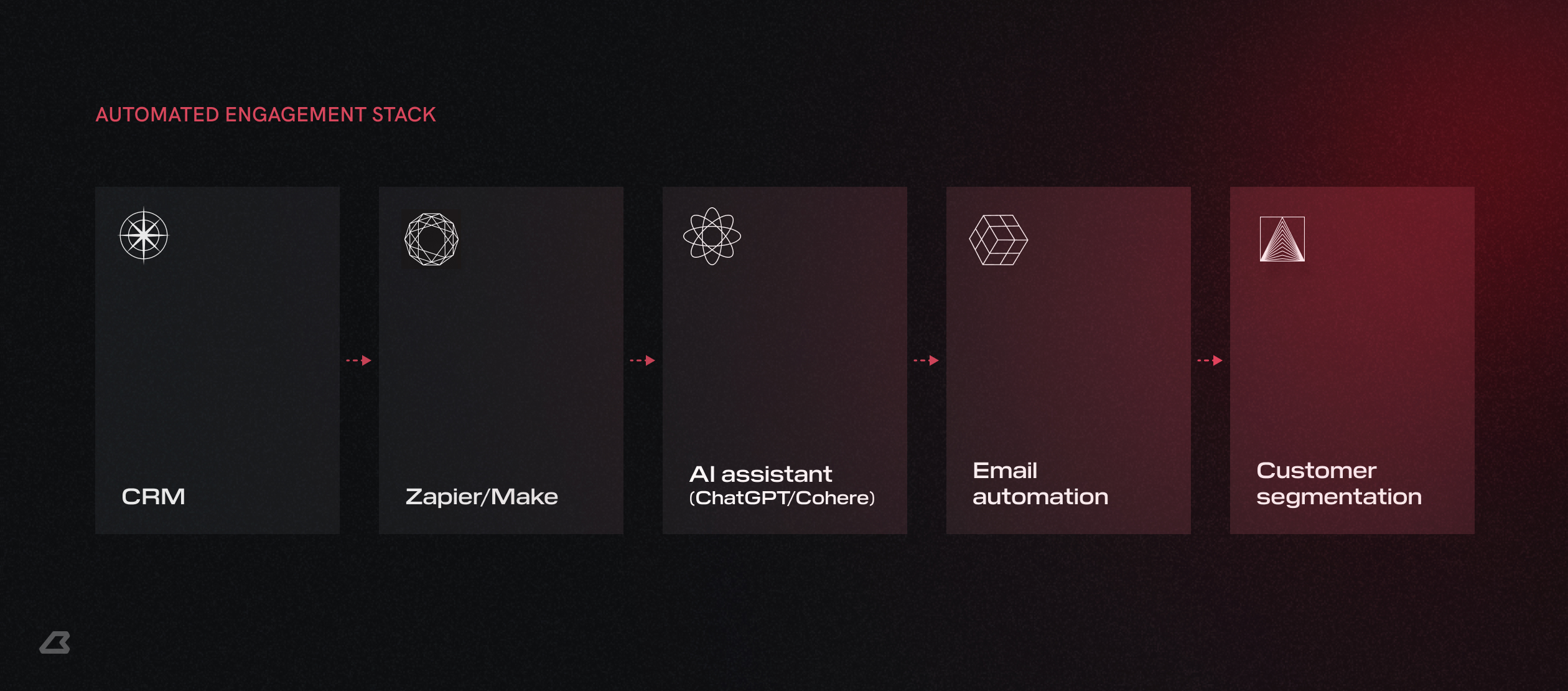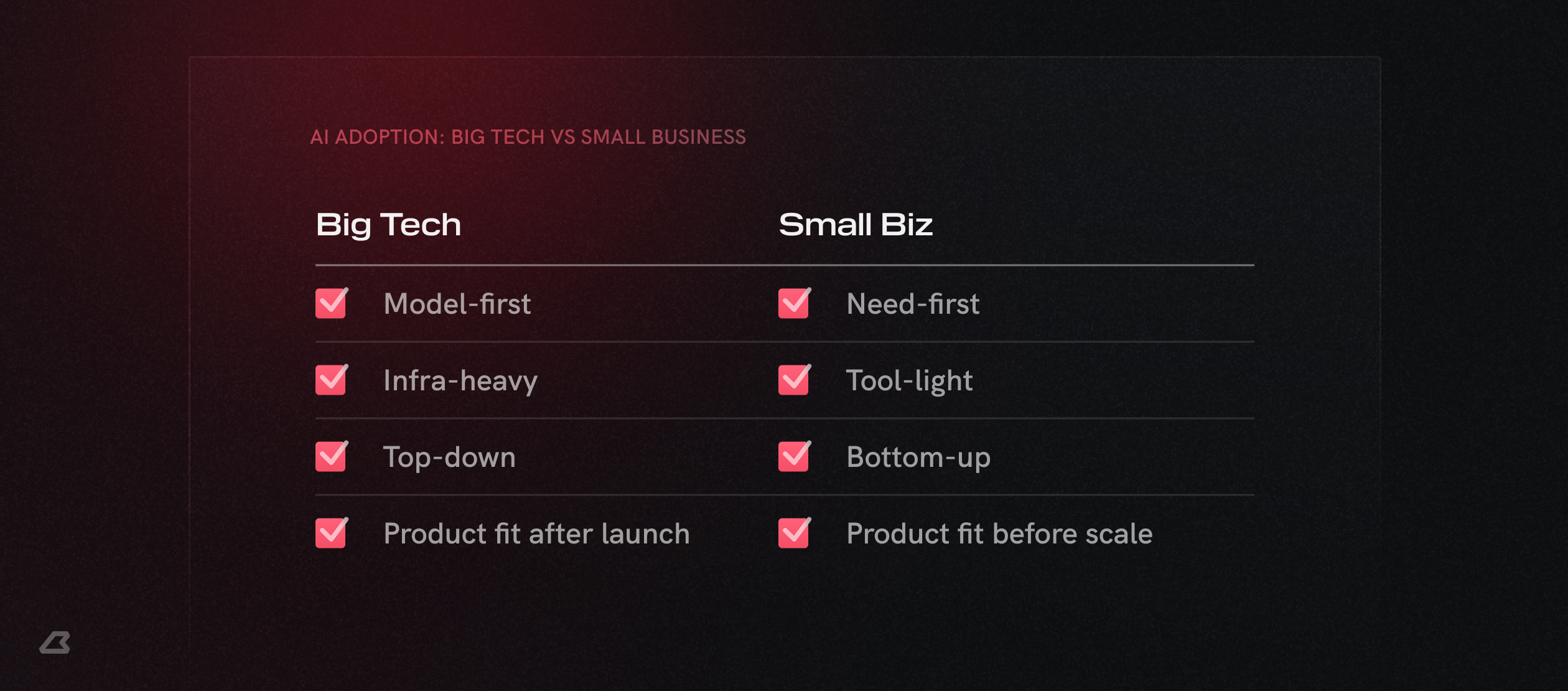Can Big Tech Can Learn from Small Businesses in the AI Era?
The AI Paradox
Why Big Tech is Struggling to Make AI Work?
In 2025, AI is no longer the shiny toy – it’s the backbone. But while Big Tech is pouring billions into R&D and rolling out sophisticated models, many of those initiatives are stalling. Meanwhile, small businesses are quietly winning. They’re not building massive foundation models. They’re deploying AI in lean, fast, human-centered ways – and it’s working.
That’s the paradox – the bigger you are, the harder it gets to make AI work.
In this article, we explore what’s holding Big Tech back, how small businesses are using AI with more speed and clarity, and what this tells us about the future of AI leadership- why impact, not infrastructure, is the new advantage.
Speed Over Size
Agility Wins in AI
Big Tech has the compute. The talent. The budget. So why is agility still out of reach?
Here’s the short answer: bureaucracy. Red tape. Risk-aversion. At scale, even innovation gets slow.
Big Tech’s AI failures often stem from over-engineering. Think massive LLMs rolled out with unclear ROI, bloated infrastructure, and a fixation on automation instead of augmentation. Internal stakeholders demand measurable returns, but AI’s value rarely comes with a quarterly KPI.
Worse, many of these deployments prioritize the model first – not the user. The result? AI that solves for the wrong problem, or no problem at all.
Contrast that with a startup automating customer responses with a GPT wrapper or a retail SME using AI to optimize inventory on Shopify. No committees. Just test, learn, launch. And when it doesn’t work? Tweak. Iterate. Ship again.
Not all tech giants are lagging behind, though. Microsoft and Amazon are showing how AI monetization can succeed by embedding it into core products, not just experimental labs. But for every win like Copilot, there are ten internal tools that never leave beta. That’s where small business agility becomes a real advantage.
AI as a Teammate, Not a Replacement
Small Business AI Playbook
Small businesses don’t see AI as a magic bullet. They see it as a teammate.
From auto-generating invoices to real-time scheduling or helping a two-person support team scale CX with AI-assisted replies, small businesses are building workflows that pair humans with machines – not replace them. This is augmentation, not automation.
It’s micro-innovation in action solving real problems at the edge of operations.
Tools like Make.com, Zapier, Notion AI, or Cohere are allowing lean teams to scale output with minimal overhead. And because these teams are often the end-users themselves, feedback loops are instant.
They’re not waiting for a vendor to patch a dashboard in Q4. They’re opening a tab, connecting the dots, and building something that works today.
As HBR points out, GenAI is leveling the playing field by giving small businesses access to the kind of cognitive horsepower that used to be reserved for tech giants. But the edge isn’t just access – it’s adaptability. The real gains come when teams collaborate with AI, not just use it.

From CRM to smart segmentation
This is what “small t” transformation looks like. It’s not about disrupting industries. It’s about compounding operational efficiency in small, smart ways
Ethics as a Competitive Advantage
What Big Companies Can – and Must – Learn
Trust isn’t a byproduct, it’s a design principle. And small businesses are ahead here, too.
Where Big Tech stumbles with black-box algorithms, opaque data use, or backlash from half-baked releases, small businesses are doing something radical: telling their customers what the AI is doing.
Transparent AI use disclosing automation, getting consent, designing with data ethics in mind – builds long-term trust. In an era of algorithmic anxiety, this is an edge.
User-centric design, human-in-the-loop systems, and feedback-first interfaces aren’t just ethical. They’re practical. They create systems people actually want to use.
Customer-Centric Design Beats Model-Centric Thinking
The best AI deployments don’t start with a model – they start with a need.
Big Tech’s traditional pyramid goes like this:
- Start with a model
- Build the infra
- Find a use case
- Hope for product-market fit
Small businesses flip the script:
- Start with a pain point
- Find a tool
- Apply it instantly
- Measure and iterate
This is well-supported by Artificial Intelligence for the Real World, which urges companies to move from hype to utility.

Enterprise vs Indie Pathways
This approach isn’t just scrappy – it’s strategic. Especially when you’re navigating complex markets with lean teams and real stakes.
Final Thoughts
Why Big Tech Needs to Think Small to Win Big in AI
Innovation doesn’t belong to size anymore. It belongs to speed, adaptability, and trust.
Small businesses are showing what the future of AI looks like – embedded, ethical, efficient. Big Tech, for all its might, is watching from the sidelines when it should be taking notes.
As Brookings notes, the coming AI-powered productivity boom won’t be led by tools alone – it’ll be driven by the organizations bold enough to experiment and adapt fast. And that’s exactly where small businesses have the upper hand.
Because the next wave of AI leadership won’t come from whoever has the biggest model. It’ll come from whoever uses it better.









